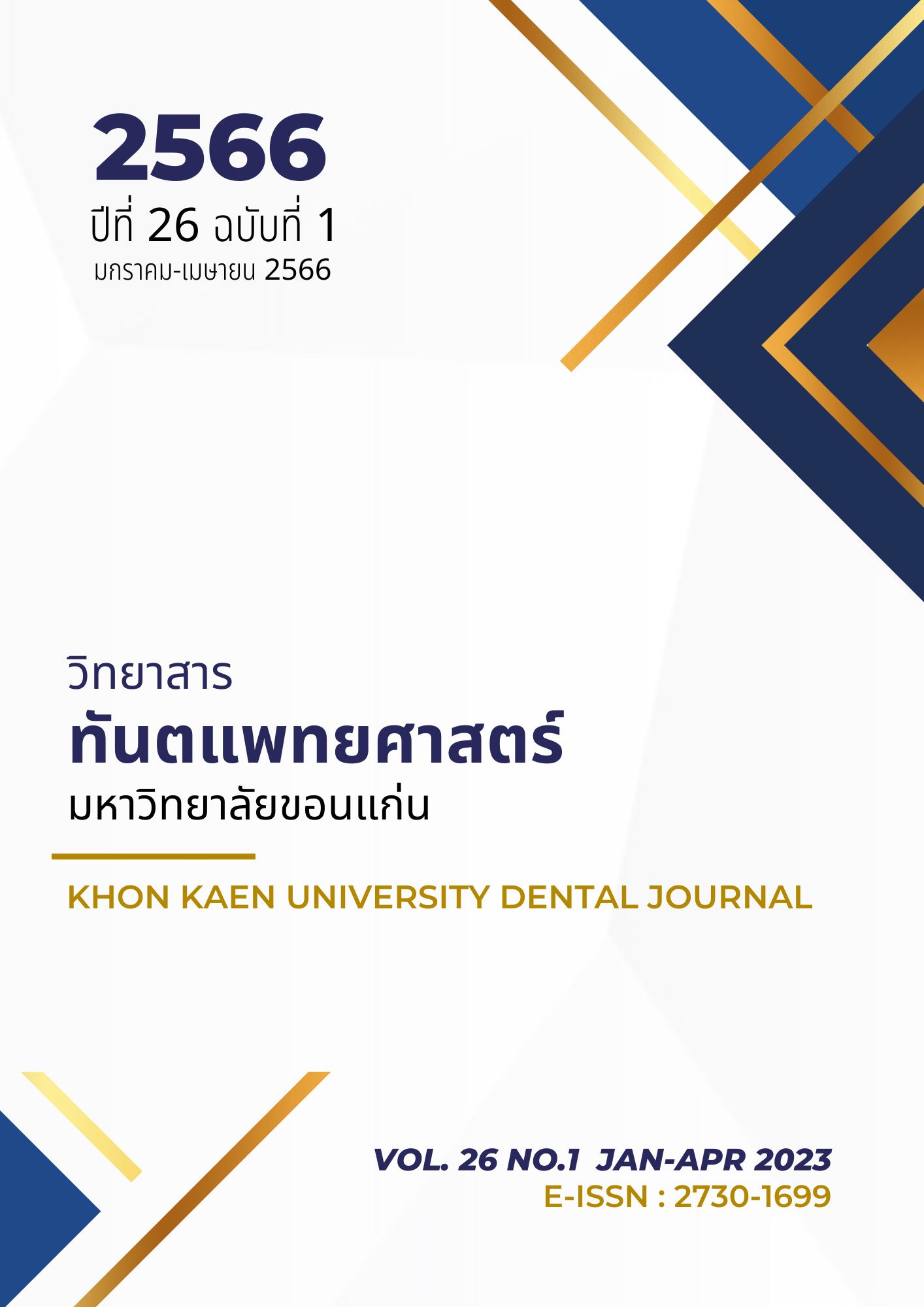ความสามารถในการต้านอนุมูลอิสระของสารละลายคลอเฮกซิดีน ที่ความเข้มข้นแตกต่างกันและผลของคลอเฮกซิดีนต่อความแข็งแรงยึดติดของเรซินคอมโพสิตในฟันที่ผ่านการฟอกสีฟัน
Main Article Content
บทคัดย่อ
การศึกษานี้มีวัตถุประสงค์เพื่อเปรียบเทียบความสามารถในการต้านอนุมูลอิสระของสารละลายคลอเฮกซิดีนที่หลากหลายความเข้มข้นกับสารละลายโซเดียมแอสคอร์เบตและเปรียบเทียบผลของการบูรณะด้วยคอมโพสิตเรซินต่อค่ากำลังแรงยึดเฉือนของเนื้อฟัน เมื่อเตรียมเนื้อฟันด้วยสารละลายคลอเฮกซิดีนกับสารละลายโซเดียมแอสคอร์เบตภายหลังการฟอกสีฟันที่ไม่มีชีวิต โดยทำการศึกษาสารละลายคลอเฮกซิดีน 5 ความเข้มข้น ได้แก่ ความเข้มข้นร้อยละ 20 ร้อยละ 10 ร้อยละ 5 ร้อยละ 2.5 และร้อยละ 1.25 ตามลำดับ และสารละลายโซเดียมแอสคอร์เบตความเข้มข้นร้อยละ 10 เพื่อนำไปวิเคราะห์หาความสามารถในการต้านอนุมูลอิสระของสารละลายผ่านกระบวนการดีพีพีเอช เอสเสย์ นำสารละลายคลอเฮกซิดีนที่มีค่าความสามารถในการต้านอนุมูลอิสระอันดับที่หนึ่งและสองมาศึกษาต่อในการเตรียมผิวฟัน โดยนำฟันกรามน้อยของมนุษย์ที่ถูกถอนจำนวน 60 ซี่ แบ่งด้วยวิธีสุ่มออกเป็น 4 กลุ่ม (N=15) กลุ่มที่ 1 เป็นกลุ่มควบคุมเชิงลบที่ไม่มีการเตรียมผิวฟัน (C1) กลุ่มที่ 2 เป็นกลุ่มควบคุมเชิงบวกที่เตรียมผิวฟันด้วยสารละลายโซเดียมแอสคอร์เบต (C2) กลุ่มที่ 3 และกลุ่มที่ 4 เป็นกลุ่มทดลองที่เตรียมผิวฟันด้วยสารละลายคลอเฮกซิดีนความเข้มข้นร้อยละ 20 (T1) และร้อยละ 10 (T2) เตรียมชิ้นตัวอย่างด้วยเครื่องตัดฟันกรอช้าให้เผยผึงเนื้อฟัน จากนั้นทำการฟอกสีฟันด้วยสารละลายโซเดียมเปอร์บอเรตเป็นเวลา 7 วัน จำนวน 3 รอบ และทำการเตรียมผิวฟันแต่ละกลุ่ม (C2 T1 และ T2) โดยนำสารดังกล่าวข้างต้นชุบสำลีวางบนผิวฟันเป็นเวลา 5 นาที จากนั้นใช้น้ำกลั่นล้างออก บูรณะทันทีโดยใช้สารยึดติดระบบเซลล์เอชแบบ 2 ขั้นตอน และก่อคอมโพสิตเรซินบนเนื้อฟันเป็นรูปทรงกระบอกเส้นผ่านศูนย์กลางและความสูง 4 มิลลิเมตร นำชิ้นตัวอย่างไปทดสอบหาค่ากำลังแรงยึดเฉือนด้วยเครื่องทดสอบยูนิเวอร์ซอลด้วยความเร็ว 1 มิลลิเมตรต่อนาที ผลการศึกษาค่ามัธยฐานของค่าความสามารถในการต้านอนุมูลอิสระของสารละลายคลอเฮกซิดีนความเข้มข้นร้อยละ 20 ร้อยละ 10 ร้อยละ 5 ร้อยละ 2.5 และร้อยละ 1.25 และโซเดียมแอสคอร์เบตเท่ากับ ร้อยละ33.44 (23.20, 43.14) 20.80 (19.23, 30.47) 23.98 (11.84, 28.60) 10.40 (9.53, 14.03) 15.86 (6.46, 17.65) และ 37.96 (34.54, 53.28) ตามลำดับ และค่ามัธยฐานของค่ากำลังแรงยึดเฉือนของกลุ่ม C1 C2 T1 T2 เท่ากับ 22.07 (18.14, 25.08) 72.69 (67.56, 81.67) 6.14 (2.91, 8.41) และ 14.30 (12.42, 23.13) เมกะปาสคาล ตามลำดับ ทำการวิเคราะห์ข้อมูลโดยใช้สถิติทดสอบของครัสคาล-วัลลิส และเปรียบเทียบคู่ต่างแพร์ไวส์ (Kruskal-Wallis test, Pairwise Comparison) จากการศึกษาพบว่าความสามารถในการต้านอนุมูลอิสระแต่ละกลุ่มไม่มีความแตกต่างกันอย่างมีนัยสำคัญทางสถิติ (p>0.05) ยกเว้น ระหว่างกลุ่มสารละลายโซเดียมแอสคอร์เบตกับสารละลายคลอเฮกซิดีนความเข้มข้นร้อยละ 2.5 และพบว่าค่ากำลังแรงยึดเฉือนแต่ละกลุ่มแตกต่างกันอย่างมีนัยสำคัญทางสติถิ (p<0.05) ยกเว้นระหว่างกลุ่ม C1 กับ T2 จากการศึกษาสรุปได้ว่าความสามารถในการต้านอนุมูลอิสระของสารละลายคลอเฮกซิดีนที่ความเข้มข้นสูงไม่แตกต่างกับสารละลายโซเดียมแอสคอร์เบต แต่ส่งผลต่อค่ากำลังแรงยึดเฉือนของวัสดุบูรณะคอมโพสิตเรซินที่น้อยลงภายหลังการฟอกสีฟันที่ไม่มีชีวิต
Article Details

อนุญาตภายใต้เงื่อนไข Creative Commons Attribution-NonCommercial-NoDerivatives 4.0 International License.
บทความ ข้อมูล เนื้อหา รูปภาพ ฯลฯ ทีได้รับการลงตีพิมพ์ในวิทยาสารทันตแพทยศาสตร์ มหาวิทยาลัยขอนแก่นถือเป็นลิขสิทธิ์เฉพาะของคณะทันตแพทยศาสตร์ มหาวิทยาลัยขอนแก่น หากบุคคลหรือหน่วยงานใดต้องการนำทั้งหมดหรือส่วนหนึ่งส่วนใดไปเผยแพร่ต่อหรือเพื่อกระทำการใด ๆ จะต้องได้รับอนุญาตเป็นลายลักษณ์อักษร จากคณะทันตแพทยศาสตร์ มหาวิทยาลัยขอนแก่นก่อนเท่านั้น
เอกสารอ้างอิง
MacIsaac AM, Hoen CM. Intracoronal bleaching: concerns and considerations. J Can Dent Assoc 1994;60(1):57-64.
Attin T, Hannig C, Wiegand A, Attin R. Effect of bleaching on restorative materials and restorations--a systematic review. Dent Mater 2004;20(9):852-61.
Madison S, Walton R. Cervical root resorption following bleaching of endodontically treated teeth. J Endod 1990;16(12):570-74.
Jung KH, Seon EM, Choi AN, Kwon YH, Son SA, Park JK. Time of application of sodium ascorbate on bonding to bleached dentin. Scanning 2017;2017: 6074253.
Muraguchi K, Shigenobu S, Suzuki S, Tanaka T. Improvement of bonding to bleached bovine tooth surfaces by ascorbic acid treatment. Dent Mater J 2007;26(6):875-81.
Shinohara MS, Peris AR, Pimenta LA, Ambrosano GM. Shear bond strength evaluation of composite resin on enamel and dentin after nonvital bleaching. J Esthet Restor Dent 2005;17(1):22-9.
Topcu FT, Erdemir U, Ozel E, Tiryaki M, Oktay EA, Yildiz E. Influence of bleaching regimen and time elapsed on microtensile bond strength of resin composite to enamel. Contemp Clin Dent 2017;8(1):451-58.
Harrison MS, Wang Y, Frick KJ, Moniz J, Walker MP. Effects of alpha-tocopherol antioxidant on dentin-composite microtensile bond strength after sodium perborate bleaching. J Endod 2019;45(8):1053-59.
Garcia EJ, Oldoni TL, Alencar SM, Reis A, Loguercio AD, Grande RH. Antioxidant activity by DPPH assay of potential solutions to be applied on bleached teeth. Braz Dent J 2012;23(1):22-7.
Yeung SY, Huang CS, Chan CP, et al. Antioxidant and pro-oxidant properties of chlorhexidine and its interaction with calcium hydroxide solutions. Int Endod J 2007;40(11):837-44.
Scaffa PM, Vidal CM, Barros N, Gesteira TF, Carmona AK, Breschi L, et al. Chlorhexidine inhibits the activity of dental cysteine cathepsins. J Dent Res 2012;91(4):420-25.
Carrilho MR, Geraldeli S, Tay F, de Goes MF, Carvalho RM, Tjäderhane L, et al. In vivo preservation of the hybrid layer by chlorhexidine. J Dent Res 2007;86(6):529-33.
Shafiei F, Fekrazad R, Kiomarsi N, Shafiei E. Bond strength of two resin cements to dentin after disinfection pretreatment: effects of Er,Cr:YSGG laser compared with chemical antibacterial agent. Photomed Laser Surg 2013;31(5):206-11.
Briso ALF, Rahal V, Sundfeld RH, Santos PHd, Alexandre RS. Effect of sodium ascorbate on dentin bonding after two bleaching techniques. Oper Dent 2014;39(2):195-203.
Trindade T, Moura L, Raucci-Neto W, Messias D, Colucci V. Bonding effectiveness of universal adhesive to intracoronal bleached dentin treated with sodium ascorbate. Braz Dent J 2016;27(3):303-08.
Nishitani Y, Hosaka K, Hoshika T, Yoshiyama M, Pashley DH. Effects of chlorhexidine in self-etching adhesive: 24 hours results. Dent Mater J 2013;32(3):420-4.
Breschi L, Mazzoni A, Nato F, Carrilho M, Visintini E, Tjäderhane L, et al. Chlorhexidine stabilizes the adhesive interface: a 2-year in vitro study. Dent Mate 2010;26(4):320-25.
Stanislawczuk R, Reis A, Loguercio AD. A 2-year in vitro evaluation of a chlorhexidine-containing acid on the durability of resin-dentin interfaces. J Dent 2011;39(1):40-7.
Ricci HA, Sanabe ME, de Souza Costa CA, Pashley DH, Hebling J. Chlorhexidine increases the longevity of in vivo resin-dentin bonds. Eur J Oral Sci 2010;118(4):411-16.
Sacramento PA, de Castilho AR, Banzi EC, Puppi-Rontani RM. Influence of cavity disinfectant and adhesive systems on the bonding procedure in demineralized dentin-a one-year in vitro evaluation. J Adhes Dent 2012;14(6):575-83.
Mobarak EH, El-Korashy DI, Pashley DH. Effect of chlorhexidine concentrations on micro-shear bond strength of self-etch adhesive to normal and caries-affected dentin. Am J Dent 2010; 23(4):217-22.
Dalli M, Ercan E, Zorba YO, Ince B, Sahbaz C, Bahsi E, et al. Effect of 1% chlorhexidine gel on the bonding strength to dentin. J Dent Sci 2010;5(1):8-13.
Hamdan-Nassar T, Bellot-Arcis C, Paredes-Gallardo V, et al. Effect of 2% chlorhexidine following acid etching on microtensile bond strength of resin restorations: a meta-analysis. Medicina (Kaunas) 2019;55(12):769.
Loguercio A, Sr R, Polli L, Costa J, Michel M, Reis A. Influence of chlorhexidine digluconate concentration and application time on resin bond strength durability. Eur J Orol Sci 2009; 117(5):587-96.
Carrilho MR, Carvalho RM, Sousa EN, Nicolau J, Breschi L, Mazzoni A, et al. Substantivity of chlorhexidine to human dentin. Dent Mater 2010;26(8):779-85.
Misra DN. Interaction of chlorhexidine digluconate with and adsorption of chlorhexidine on hydroxyapatite. J Biomed Mater Res 1994; 28(11):1375-81.
Freitas C, Diniz H, Gomes J, Sinisterra R, Cortés M. Evaluation of the substantivity of chlorhexidine in association with sodium fluoride in vitro. Pesqui Odontol Bras 2003;17(1):78-81.
Hipólito V, Salvio L, Martins A, Goes M. Hybridization quality and bond strength of adhesive systems according to interaction with dentin. Eur J Dent 2013;7(3):315-26.
Zhou J, Tan J, Chen L, Li D, Tan Y. The incorporation of chlorhexidine in a two-step self-etching adhesive preserves dentin bond in vitro. J Dent 2009;37(10):807-12.
Van Landuyt KL, Snauwaert J, De Munck J, Peumans M, Yoshida Y, Poitevin A, et al. Systematic review of the chemical composition of contemporary dental adhesives. Biomaterials 2007;28(26):3757-85.


